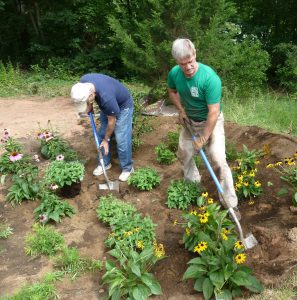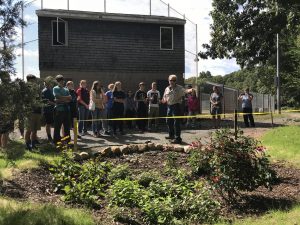
What goes on the ground goes into the Sound…the Friends of Oswegatchie Hills Nature Preserve take this adage to heart.
The Oswegatchie Hills Nature Preserve (OHNP), established in 2007, protects almost 500 acres of pristine coastal forest for passive recreation, habitat for wildlife, and coveted open space surrounded by urban development. The undeveloped coastal forest on the East Lyme bank of the Niantic River also serves as a natural filter, slowing down, catching, and filtering pollution and sediment from rain and storm water runoff on the way into the estuary and Long Island Sound.
The OHNP main entrance is conveniently located next to a heavily used town baseball field and parking lot. Teams of volunteers have been working to stop soil erosion and pollution runoff into Clark Pond, a stunning landmark and starting point for the preserve’s main hiking trails. Historic records indicate that in the 1800s and early 1900s ice was harvested from the pond and hauled down the road to the Village of Niantic for the local fishing fleet. Today it is home for wood ducks, green herons, the occasional beaver and other wildlife.
In 2012, the Friends, Eastern Connecticut Conservation District (ECCD), the Town of East Lyme, and landscape designer Dew Kenny, removed invasive species and planted a riparian buffer of native grasses, wildflowers, and berried shrubs to stabilize the slope from the ball field to the pond. The native plants have taken hold, attracting birds and pollinating insects while reducing pollution runoff. The established meadow and shrubs also set the stage for hikers on the Red Trail, a steep climb into craggy outcroppings in the coastal forest.

This fall, volunteers added a rain garden between the riparian buffer and a service road that has continued to cause erosion problems. Rain gardens are designed to catch, hold, and filter excess water for up to two days, so plants need to be able to survive short wet spells as well as drought conditions. The ECCD provided these native pollinator-friendly plants for the new bed: Butterfly Weed (Asclepius tuberosa), Coneflower (Echinacea), Winterberry (Ilex verticillate), Beebalm (Monarda), Black-eyed Susan (Rudbeckia) and Mountain Mint (Pycnanthemum).
The Friends welcome you to come hike OHNP, watch here for latest updates on trails and organized hikes.
Our Save Oswegatchie Hills Coalition, founded by Connecticut Fund for the Environment and the Friends of OHNP, seeks to protect the remaining undeveloped Oswegatchie Hills, 236 acres that abut the existing preserve. A developer is proposing high-density housing for this abutting property. See how you can join our cause to protect this land for future generations.
